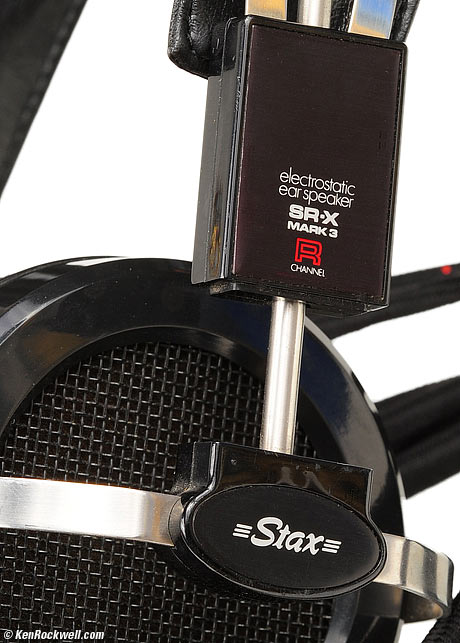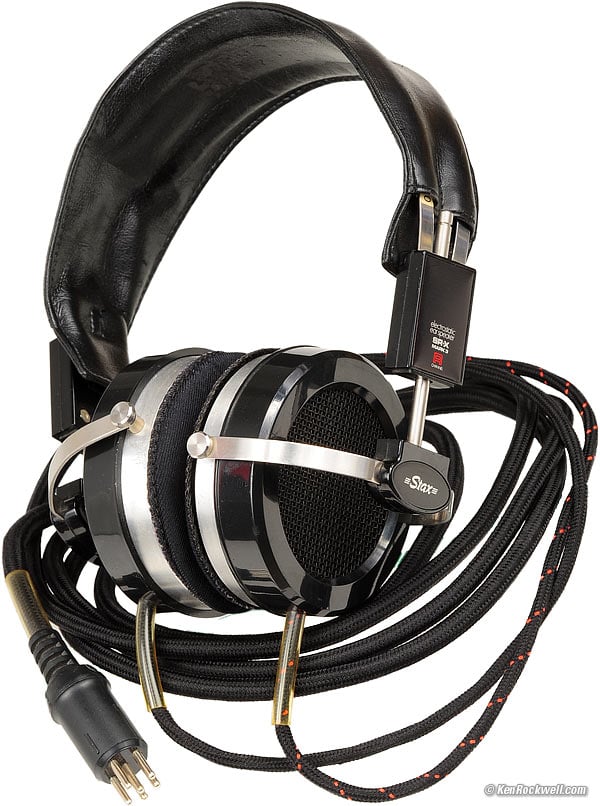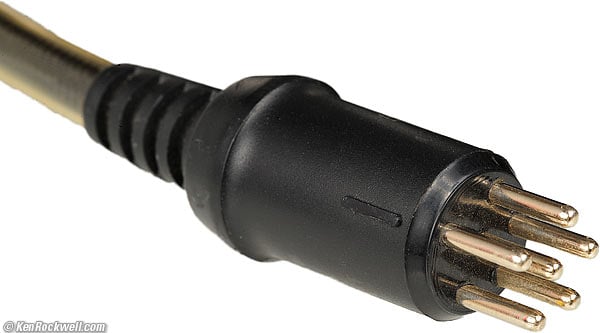Home Donate New Search Gallery Reviews How-To Books Links Workshops About Contact
Stax SR-X Mark 3 (SRX-III)
(1975-1979)
© 2011 KenRockwell.com. All rights reserved.
Intro Specs Performance Compared Usage Recommendations
Stax SR-X Mark 3. enlarge. This free website's biggest source of support is when you use these links, especially this link directly to them at eBay, where they sell for about $150 (see How to Win at eBay). It helps me keep reviewing these oldies when you get yours through these links, thanks! Ken.
April 2011 All Reviews Audio Reviews Stax Reviews
Electrostatic Headphones: How They Work, and Why They Sound Better.
Audio-Technica Beyer Sennheiser Sony Stax Ultrasone Velodyne Woo
Introduction top
Intro Specs Performance Compared Usage Recommendations
|
I personally buy from Adorama, Amazon, Ritz, B&H, Calumet and J&R. I can't vouch for ads below.
|
These Stax SR-X Mark 3 electrostatic headphones are decades old, and still outperform conventional dynamic headphones like the Sennheiser HD 800 and Ultrasone Edition 8 in most ways, especially for clean, open, natural sound. Better, these Stax headphones, used, sell for one-tenth the price.
When introduced in 1975, these Stax SR-X Mark III were the world's highest performance headphones, unchallenged until Stax introduced the even more exotic SR-Sigmas in late 1977.
These are not ordinary headphones that use a coil of wire inside a magnet glued to a heavy diaphragm, like mass-market products from Sennheiser, Ultrasone and Beyer. These are electrostatic headphones. Electrostatic technology is far superior for reproducing sound. Comparing the performance of one completely different technology to another, like electrostatic to dynamic transducers, is like comparing the speed of a bicycle to the speed of a car. Even if you've got Lance Armstrong's brand-new million dollar bicycle, my beater 1974 slant-six Plymouth Duster goes a lot faster and farther.
This Stax SR-X Mark 3 may look like something pulled out of a WWII Japanese submarine, but its proven electrostatic technology excels at super-low distortion and freedom from any resonance or coloration.
These headphones win on subtlety. If you want to enjoy every nuance of your music over hours and hours of careful listening, these are your headphones. If you prefer something that boosts everything for an impressive 30-second demo blast, these aren't.
Stax invented electrostatic headphones in 1959, and had 16 years of experience optimizing them when these were introduced. Stax' marketing people have always called these "earspeakers" instead of headphones.
These SR-X Mark III aren't that much different than the previous SR-X headphones, and look similar to a black version of Stax' very first SR-1 of 1959. Honestly, the Stax New SR-3 (1971-1975) are more different in looks than in actual performance from these newer SRX-IIIs.
While Stax' newer and better headphones went to rectangular housings and elliptical drivers with the SR-Sigma of 1977 and continue to this day, Stax' top-model Omega introduced in 1993 was round again, and to this day, the round SR-009 of 2011 is Stax' very top $5,000 model. Maybe there's something to be said for round drivers?
Specifications top
Intro Specs Performance Compared Usage Recommendations
Name

Stax SR-X Mark 3.
These are marked "Stax SR-X Mark 3," and have also been referred to in advertisements as the SRX-III, as well as the SR-X Mk III, and plenty of other variations thereof.
Input
Connects to any Stax standard (230 V bias) 6-pin adapter, energizer or amplifier.
Won't connect to any Pro or Professional (580 V bias) 5-pin adapter, energizer or amplifier.
Cord
Straight, supple black cloth-covered round cord.
The red blip is the right channel.
2.5 meters (8 feet) long.
Soft, about 6mm (1/4") diameter, measured.
It's a much better cable than the cheap plastic cable of the Ultrasone Edition 8. It feels just like the cable of the Sennheiser HD 800, however this Stax cable has the same microphonics as most cables, not the mysteriously silent cable of the Sennheiser HD 800. ("Microphonics" mean that if you rattle the cable against something, that the sound is transmitted mechanically through to the headphones.)
Diaphragm
2 microns thick.
For comparison, a very thin dry-cleaning plastic bag, the type that blows away just by breathing on it, measures about 20 microns!
Plate Spacing (electrode gap)
300 microns.
Capacitance
120 pF.
Impedance
130 k Ohm at 10 kHz.
Frequency Response
30 - 25,000 Hz, rated (tolerance not stated).
Stated elsewhere as 20 - 70,000 Hz, unstated tolerance.
Sensitivity
97 dB SPL with 100V RMS input at 1 kHz, 230 V bias.
Maximum Output Level
110 dB SPL, 230 V bias.
Stated elsewhere as 115 dB.
Weight (actual measured)
10.2 oz. (290g), without cord.
12.590 oz. (357.0g), with original cord and plug.
Price
When new, these were the world's best, and priced to match.
In 2011, expect to pay about $150 used for the SR-X Mark 3. You will also need a dedicated Stax energizer, adapter or amplifier.
Performance top
Intro Specs Performance Compared Usage Recommendations
Sound Quality top
Overall
See also Electrostatic Headphones: How They Work, and Why They Sound Better.
The SR-X Mark 3 sounds great! As I said above, it's smooth, uncolored, undistorted, natural, clean, clear and open. Everything sounds great, especially real acoustic and vocal music. The SR-X Mark 3 are non-fatiguing for hours and hours and hours of continuous enjoyment.
There is NO distortion, not even the 1% most people accept from conventional transducers as being part of life. The ultralight diaphragm ensures no acoustic energy storage, meaning that there is none of the time-smearing and resonances of other headphones to muddy the sound.
The SR-X Mark III are smooth and wonderful. I prefer these SR-X Mark 3 to the overly-bright and uncomfortable Sennheiser HD 800.
Everything is balanced and natural with the SR-X Mark III. The biggest limitation to sound quality is your recordings. Vocals are incredible, but many popular recordings do so many weird things to vocals to make them stand out from the band that these limitations will become quite obvious with the SR-X Mark 3.
With the SR-X Mark III, everything sounds as it ought to. Everything is in its place, with incredible detail and open soundstage. Everything sounds distinct from everything else. Nothing mushes into anything else. Every voice, multitrack layer and instrument is heard distinctly as it should be, not as a bland wall-of-mixed-up-crud.
Bass
The particular pair I borrowed to review had an aftermarket set of soft cloth earpads that don't seal as well and aren't as deep as the standard Kobe vinyl earpads. I think that's why these lack a little bass compared to the similar Stax New SR-3.
Otherwise, bass is great. Bass is tight, controlled, separate and without any of the inherent resonance of all magnetic (conventional coil-magnet) speakers and headphones. What you hear is exactly what's there, albeit a little less due to my particular set's custom earpads.
Soundstage
Soundstage is what we expect from headphones.
I love it, and prefer it to speakers.
On-center things are centered and coherent.
Power
The SR-X Mark 3 go LOUD. My ears gave up long before they did, and the SR-X Mark III do it with zero distortion.
These electrostatic headphones don't have the limited power output limitations of electrostatic loudspeakers.
Comfort top
The Stax SR-X Mark 3 is a supra-aural headphone, meaning it sits on top of your ears.
These had an aftermarket set of very thin pads, which I found less comfortable than the standard, thicker Kobe vinyl pads.
The unpadded top harp eventually wore the top of my head. Since it's got a large radius to look good, it puts most of its weight on the very top of one's head.
Mechanical Quality top
I'm impressed: the metal seems to be mostly 18-8 stainless steel! You don't get that from Sennheiser.
The standard earpads are premium Kobe vinyl (not seen on this sample).
Compared top
Intro Specs Performance Compared Usage Recommendations
Newer Stax earspeakers are a bit brighter, and play louder, but I'm not a fan of brightness or listening too loud.
These SR-X Mark III go more than loud enough.
I'm waiting to replace the earpads with standard ones before I pass too much judgment. As these stand, they are my last pick compared to the New SR-3 and the SR-Lambda Pros, but I think this is due to having my ears too close to the diaphragms and less sealed than they are intended. As they stand today, I find these SR-X Mark III a bit brighter than the New SR-3, but not as bright a the Lambda Pro.
Usage top
Intro Specs Performance Compared Usage Recommendations
Compatibility
6-pin molded plug, Stax SR-X Mark 3. enlarge.
As you can see by the funny molded connector, the Stax SR-X Mark 3 must be used with one of Stax' dedicated energizers, adapters or amplifiers.
The SR-X Mark III operates with Stax' traditional 230 V bias and 6-pin sockets, so it works with all energizers and most amplifiers, except any 5-pin sockets marked "pro" or "professional," which use 580 V bias. The SR-X Mark 3 can't be plugged into the 5-pin sockets, which is because it can't handle the 580 V professional polarizing voltage.
When sold new, it was most commonly sold with the hokey SRD-7 passive adapter, or occasionally the super-premium Stax SRA-12A Integrated Amplifier.
Safety top
Watch for High Voltage when unplugging the headphones from an adapter, energizer or amplifier.
It seems easy to grab the pins by accident as you insert or remove the plug from a socket, and if you touch them while energized, you may get a jolt of 230 Volts.
Beware: these voltages stay in this equipment for a long time, even when unplugged. Be careful!
Charge Time top
This system uses static electricity, meaning non-moving (static) electric charges.
The static charge, a.k.a. polarizing voltage, is supposed to take a few minutes to spread around the headphone's diaphragm. If the charge was free to move at will, it would move under the forces that are supposed to move the diaphragm when subjected to voltage fields from the plates. If the charge was free to move (not static), electrostatic headphones and speakers wouldn't work.
Therefore, it takes time for the static charge to spread across the entire diaphragm.
As the charge spreads, it is normal for the audio to increase in level for the first few minutes after you've plugged the adapter into the wall. It's also normal for each channel to come up at slightly different rates, meaning it is expected that for the first few moments the channels often seem unbalanced.
Personally, I leave this thing plugged in and energized all the time, so my headphones are always ready to go. It's hard to measure, but electrostatic systems love to be left alone — that's why they're called static, and not dynamic. Some people say, and I wouldn't disagree with them, that electrostatic systems sound best if they're left plugged in for at least a day.
Man-Handling top
The diaphragms are virtually weightless, and float around in the air between two perforated metal plates.
Stax cautions that if you press these against your head, the diaphragm might move to one side of the 300 micron space between the perforated plates in which it operates, and discharge its polarizing voltage through that plate.
In other words, if you hear a Pop! while moving these around, that's normal.
I've also had this happen if I put them down too quickly on a hard table: the diaphragm wiggles too much, touches one of the plates, and discharges.
When either of the diaphragms discharges this way, it doesn't hurt anything, but you will lose most of your bass response for a minute while the static charge builds back up across the diaphragm.
Recommendations top
Intro Specs Performance Compared Usage Recommendations
The Stax SR-X Mark 3 is one of the least expensive ways to get the best headphone sound available.
Electrostatic headphones are in a completely different class above the primitive electrodynamic (coil in a magnet) systems used in almost all mass-market headphones and loudspeakers, like that Sennheiser.
If you want to spend more, and you probably do if you're reading this, the newer Professional (580 V) amplifiers and Lambda headphones sound even better, but also brighter. I love listening to these SR-X Mark III directly, but when I listen to the SR-Lambda Professional, many recordings demand I use an equalizer to lose a couple of dB around 4 kHz for them to sound great to me.
The bass of the SR-X Mark 3 sounds great, but if you want to beat yourself senseless with loud, deep bass, the SR-Lambda Professional and newer Stax pro-series headphones are designed specifically to do this even better.
With the aftermarket earpads as shown, these are good for flat recordings, but a little bright with bright recordings, and a little shy on deep bass. I'm hoping the original pads rectify this; we'll see.
A beauty of the complete Stax system is that everything is pretty much compatible with everything, with the only caveat that these older headphones won't work with newer amplifiers that only have Pro (580V) outputs.
If you find the efforts I put into sharing this information helpful, this free website's biggest source of support is when you use these links, especially this link directly to them at eBay, where they sell for about $150 (see How to Win at eBay). It helps me keep reviewing these oldies when you get yours through these links, thanks! Ken.
Help me help you top
I support my growing family through this website, as crazy as it might seem.
The biggest help is when you use any of these links to Adorama, Amazon, eBay, Ritz, Calumet and J&R and when you get anything. It costs you nothing, and is this site's, and thus my family's, biggest source of support. eBay is always a gamble, but all the other places always have the best prices and service, which is why I've used them since before this website existed. I recommend them all personally.
If you find this page as helpful as a book you might have had to buy or a workshop you may have had to take, feel free to help me continue helping everyone.
If you've gotten your gear through one of my links or helped otherwise, you're family. It's great people like you who allow me to keep adding to this site full-time. Thanks!
If you haven't helped yet, please do, and consider helping me with a gift of $5.00.
As this page is copyrighted and formally registered, it is unlawful to make copies, especially in the form of printouts for personal use. If you wish to make a printout for personal use, you are granted one-time permission only if you PayPal me $5.00 per printout or part thereof. Thank you!
Thanks for reading!
Mr. & Mrs. Ken Rockwell, Ryan and Katie.
Home Donate New Search Gallery Reviews How-To Books Links Workshops About Contact





